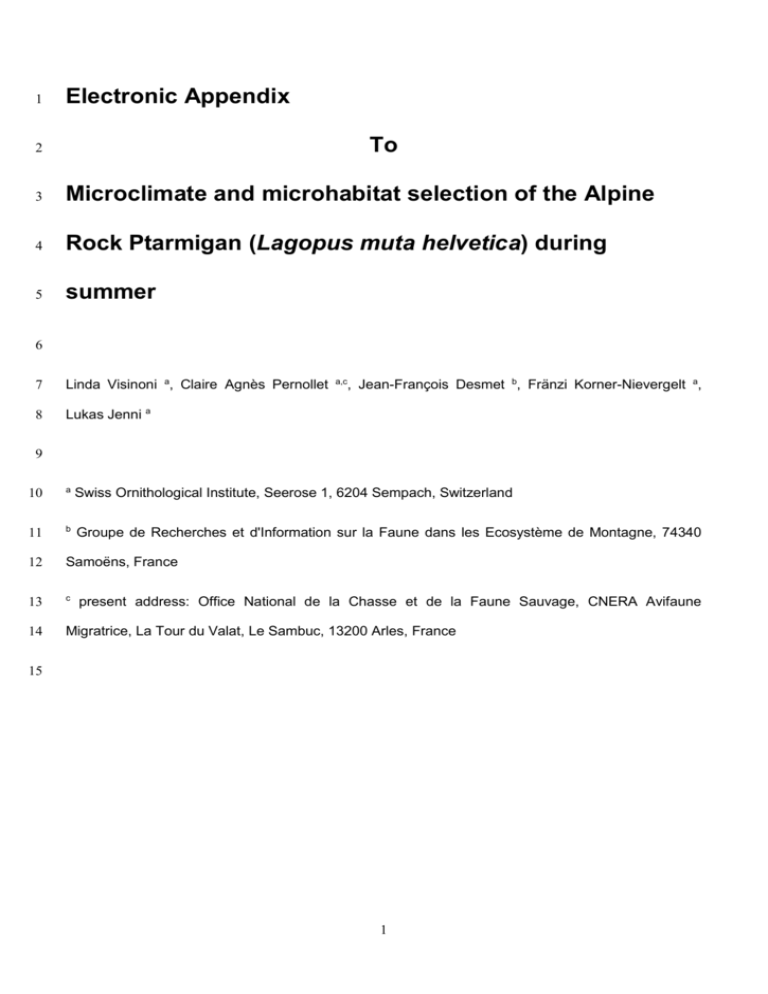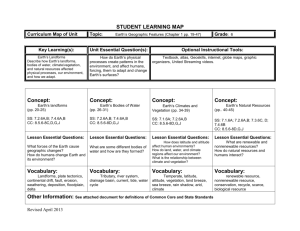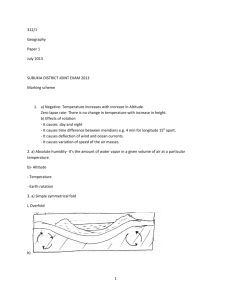(Lagopus muta helvetica) during summer
advertisement

1 Electronic Appendix To 2 3 Microclimate and microhabitat selection of the Alpine 4 Rock Ptarmigan (Lagopus muta helvetica) during 5 summer 6 7 Linda Visinoni a, Claire Agnès Pernollet 8 Lukas Jenni a a,c , Jean-François Desmet b, Fränzi Korner-Nievergelt a, 9 10 a Swiss Ornithological Institute, Seerose 1, 6204 Sempach, Switzerland 11 b Groupe de Recherches et d'Information sur la Faune dans les Ecosystème de Montagne, 74340 12 Samoëns, France 13 c 14 Migratrice, La Tour du Valat, Le Sambuc, 13200 Arles, France present address: Office National de la Chasse et de la Faune Sauvage, CNERA Avifaune 15 1 16 Appendix S1: Daily course of ground temperature at four different microtopographic sites 17 Below a rock, mean ground temperature did not vary much between day and night; it was slightly 18 higher at night and much lower during the day than at the other three sites (Fig. S1a). Also the 19 variance between days was smaller than at the other three sites (Fig. S1b). The highest mean 20 ground temperatures during the day and the lowest during night were reached on rocks with 21 vegetation, probably because of the combined effects of heat absorbed by the rock and protection 22 from cooling winds by the vegetation during the day and efficient heat dissipation during the night. 23 Somewhat lower temperatures during the day were reached in the vegetation and on bare rocks. On 24 bare rocks temperatures were higher in the evening than at the other sites, probably because of the 25 heat stored by the rocks. The variance between days was generally high (SD about 7 °C during the 26 day) and highest in the vegetation (SD about 10 °C in the afternoon). Ground temperature on rocks 27 with vegetation reached up to 45 °C on hot summer days. During five bad-weather days, the diurnal 28 raise in ground temperature was much less pronounced (not shown). 29 30 31 32 Fig. S1 Daily course of ground temperature at four different microtopographic sites (below rock, in 33 vegetation, on bare rock, on rock with vegetation). (a) Lines are hourly means of 5 different locations 34 over 33 days. (b) Lines are standard deviations and represent the variance between days 35 independent of location (see Methods). The standard deviations are of residuals from a linear model 36 with ground temperature as the dependent variable and location, site, hour and site × hour as 37 independent variables, thus represent the variability between days independent of location. Dotted 2 38 line = below rock, dashed line= on bare rock, solid line = in the vegetation, dot-dashed line = on rock 39 with vegetation. 40 41 3 42 43 44 45 Fig. S2 Contour plots of the microclimate variables (a) air temperature, (b) ground temperature, (c) 46 wind speed, (d) solar radiation, (e) relief (depth), (f) vegetation height in one of the two grid-squares. 47 The plane, given by the X- and Y-axes, represents the grid plane of 2 x 2 m with measurement points 48 every 50 cm. The means of seven measurements were used to construct the plot. Light areas 49 represent high values, dark areas low values. 50 4 51 Table S1 Microclimate characterisation of the four microtopographic sites. n = 114 per 52 microtopographic site and microclimate variable. The measurements were taken between 1130 and 53 1630 hours on days without rain. 54 Microtopographic site Below rock On bare rock On rock with vegetation In vegetation Ground temperature (°C) Air temperature (°C) Mean ± SD 16.8 ± 4.2 23.8 ± 5.5 25.4 ±7.586 22.6 ± 5.5 Min − Max 9.3 − 32.9 9.1 − 38.1 11.0 − 45.2 10.6 − 44.4 Mean ± SD 20.1 ± 3.0 20.2 ± 2.8 20.3 ± 7.6 22.3 ± 4.0 Min − Max 14.6 − 29.1 14.7 − 31.7 14.6 − 30.7 14.0 − 35.2 Wind speed (m/s) Mean ± SD 0.19 ± 0.29 0.60 ± 0.46 0.52 ± 0.49 0.14 ± 0.22 Min − Max 0 − 1.30 0 − 2.60 0 − 3.20 0 − 0.90 Solar radition (W/m2) Mean ± SD 48 ± 128 769 ± 338 667 ± 409 449 ± 325 Min − Max 1 − 772 54 − 1413 24 − 1410 19 − 1250 55 56 5 57 Table S2 Linear mixed models testing for the effects of vegetation height and relief on wind speed, 58 solar radiation, air and ground temperature in the two grid-squares (n = 350). Depth is the vertical 59 distance from an imaginary horizontal plane at the highest point of the square to the measurement 60 point. In each model, grid identity and date were included as random factors. * = p < 0.05, ** = p < 61 0.01, *** = p < 0.001 62 Estimate ± SE t-value CI 95 % Sign. Depth 0.05 ± 0.03 2.01 0.003 − 0.10 * Vegetation height 0.10 ± 0.03 4.14 0.06 − 0.16 ** Depth×Vegetation height -0.002 ± 0.002 -1.144 -0.005 − 0.001 Depth -0.10 ± 0.05 -2.12 -0.20 − -0.009 * Vegetation height -0.46 ± 0.05 -9.62 -0.55 − -0.36 *** Depth×Vegetation height 0.006 ± 0.003 1.74 -0.001 − 0.012 Depth -0.78 ± 2.38 -0.33 -5.14 − 3.79 Vegetation height -4.86 ± 2.39 -2.03 -9.24 − -0.32 Depth×Vegetation height -0.21 ± 0.16 -1.31 -0.53 − 0.07 -0.004 ± 0.004 -1.05 -0.01 − 0.004 Vegetation height -0.03 ± 0.004 -7.08 -0.04 − -0.02 Depth×Vegetation height 0.0001 ± 0.0003 0.37 -0.0005 − 0.0006 Air temperature Ground temperature Solar radiation Wind Depth 63 64 6 * *** 65 Table S3 Results of generalized linear mixed models comparing the topography of points of 66 ptarmigan with their corresponding control point at 5 m or at 30 m (likelihood-ratio tests, 6 separate 67 models). Observation event, triplet and individual were included as random factors. Sample sizes 68 were n = 42 triplets for exposition and n = 59 triplets for microtopography and slope. 69 2 df Bird versus control 5 m 20.4 4 < 0.001 Bird versus control 30 m 20.4 4 < 0.001 Bird versus control 5 m 32.2 2 < 0.001 Bird versus control 30 m 17.6 2 < 0.001 Bird versus control 5 m 4.9 3 0.17 Bird versus control 30 m 4.1 3 0.25 p-value Exposition Microtopography Slope 70 71 7







